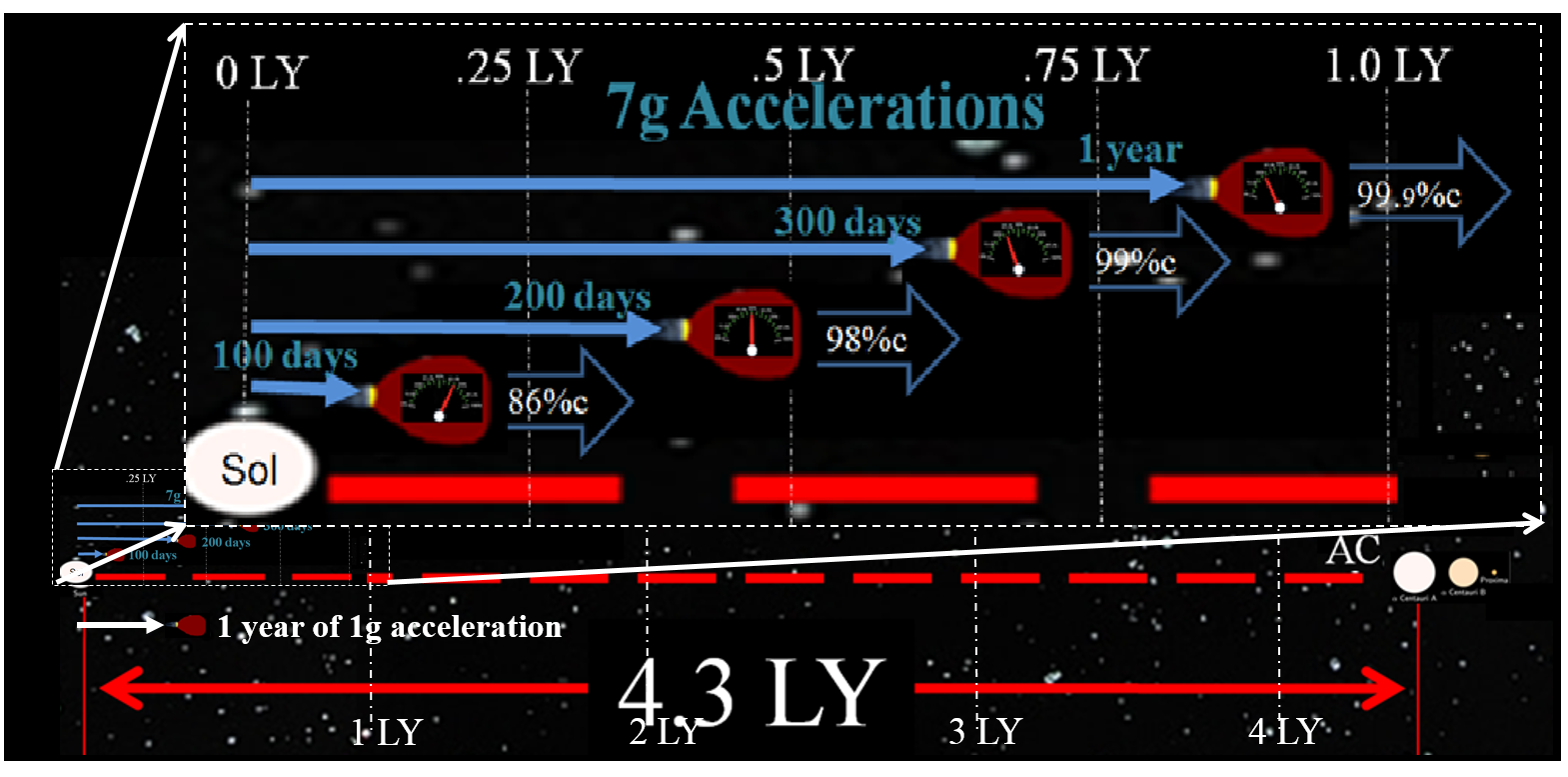INTERSTELLAR SUPER G
If g-force is great, is super g-force even greater?
 Expectations continually adjust to ever higher levels. For example, it's very possible that someone will become a dot com billionaire; you'd think she'd be happy forever. However, relevant experience indicates such happiness lasts for a much shorter time.
Expectations continually adjust to ever higher levels. For example, it's very possible that someone will become a dot com billionaire; you'd think she'd be happy forever. However, relevant experience indicates such happiness lasts for a much shorter time. 
Our billionairess will soon learn that a billion dollars is not infinite, and materialistic desires will quickly grow to accommodate that finite amount. For instance, she can fly her private jet; but she now dreams of space travel.
In similar fashion, consistent g-force propulsion will prove a great boon to interstellar travelers as g-force propulsion will reduce interstellar voyage durations from centuries to years. However, humans will soon want even faster transport for much quicker cargo deliveries. Interstellar shipments of essential materials could be greatly expedited if they could fly at super-g.
See associated 7G TABLE: Accelerate for 100 Days.
  Near Earth's surface, a free falling object will accelerate at rate g, approx. 9.8 m/sec2. Near Earth's surface, a free falling object will accelerate at rate g, approx. 9.8 m/sec2. Thus, an acceleration of 10 g would be about 98.1 m/sec2.
Using Newtonian motion equations, we previously determined the first second of 1-g free fall will move object 4.9 meters. Extend to one day of constant g-force acceleration to move vessel to .245 Astronomical Units (AUs).
|
Expand our thought experiment's envelope to exceed g-force acceleration for selected vessels. Assume no humans, but Artificial Intelligence (AI) devices will guide a vessel with essential cargo.
If double g-force does not damage ship or contents; then, much shorter travel time would be an enormous benefit.
| |||||||||||||||||||||||||||||||||||||||||||||||||||||||||||||||||||||||||||||||||||||||||||||||||||||||||||||||||||||||||||
First Day of i×G-force Propulsions
| ||||||||||||||||||||||||||||||||||||||||||||||||||||||||||||||||||||||||||||||||||||||||||||||||||||||||||||||||||||||||||||
|---|---|---|---|---|---|---|---|---|---|---|---|---|---|---|---|---|---|---|---|---|---|---|---|---|---|---|---|---|---|---|---|---|---|---|---|---|---|---|---|---|---|---|---|---|---|---|---|---|---|---|---|---|---|---|---|---|---|---|---|---|---|---|---|---|---|---|---|---|---|---|---|---|---|---|---|---|---|---|---|---|---|---|---|---|---|---|---|---|---|---|---|---|---|---|---|---|---|---|---|---|---|---|---|---|---|---|---|---|---|---|---|---|---|---|---|---|---|---|---|---|---|---|---|---|
Attain Great Speeds with 1-G Propulsion
Re-express light speed, c
Daily Difference:
and equivalent AUs per day. For lesser velocities, Einstein and Newton velocities are fairly close. |
Much Greater Speeds with 10 G Propulsion
Daily Difference for 10g propulsion
Daily Remainder for 10g propulsion
For 10g propulsion, let R = .9717.
After 10 days of 10-g propulsion,
Einsteinian velocity significantly differs from Newtonian velocity. TE assumes Einsteinian velocity is more accurate. See next table. | |||||||||||||||||||||||||||||||||||||||||||||||||||||||||||||||||||||||||||||||||||||||||||||||||||||||||||||||||||||||||||
| ||||||||||||||||||||||||||||||||||||||||||||||||||||||||||||||||||||||||||||||||||||||||||||||||||||||||||||||||||||||||||||
| ||||||||||||||||||||||||||||||||||||||||||||||||||||||||||||||||||||||||||||||||||||||||||||||||||||||||||||||||||||||||||||
VExh = dc×c =.992c = 99.2% light speed
As shown in the right hand panel, 1.0 kg of ffsec will grow to become 8.0 kgs of exhaust fuel flow, ffExh, just before it exits vessel and contributes to forward momentum. NOTE: Consume fuel particles at rest; expel at relativistic speeds.
ffExh = n × ffsec
|
For convenience, note following identities:
Growth Factor (n)
Uses Lorentz Transform (LT) as shown.
Decimal Component (dc)
If particle speed is expressed as decimal light speed; then, dc is the decimal portion.
LT can be rewritten
to solve for dc (see table at right).
Thus, conveniently generate below table.
but n could also be a rational number greater than 1. To discuss following tables, TE arbitrarily assumes a relativistic growth factor of 8. | |||||||||||||||||||||||||||||||||||||||||||||||||||||||||||||||||||||||||||||||||||||||||||||||||||||||||||||||||||||||||||
Determine ratio
of daily fuel
to Ship's Mass
Daily fuel =
86,400 seconds
of at-rest fuel consumption
To determine ship's mass:
Recall Momentum Exchange
Huge mass of ship × small velocity increase =
tiny collective mass of fuel exhaust particles × huge relativistic velocity.
Divide each side by one second for useful restatement.
| Substitute and re-arrange:
State ship's acceleration (AShip) as multiple of g, Earth's gravity:
Further
simplify:
Recall decimal component in terms of n, growth factor:
Make following substitutions:
Light speed, c = 299,792,458 m/sec
Earth gravity, g = 9.8065 m/sec²
Make following substitutions:
Growth factor, n = 8
√(n2-1) = 7.937
If perfectly efficient vessels were possible; then, a 7g-force vessel could use 1% of it's GW for 4 days propulsion. However, we must also consider
INEVITABLE INEFFICIENCIES!!
TE proposes a coefficient {efficiency factor (ε)} to increase fuel consumption (∇ ) to cover both the Exhaust Flow (ffExh=n×ffsec) and inevitable particle losses: design flaws and peripheral systems.
| |||||||||||||||||||||||||||||||||||||||||||||||||||||||||||||||||||||||||||||||||||||||||||||||||||||||||||||||||||||||||||
 Synchrotronic Propulsion System Synchrotronic Propulsion Systemwill have inevitable inefficiencies. However, they will improve over time. |
Inefficiency (E'= loss/input) reflects the inevitable loss of consumed fuel particles which will not exit the vessel to contribute to ship's velocity increase. This loss may be intentional such as particles diverted for other services. Loss may be unintentional due to design flaws. TE assumes that subsequent designs will decrease particle loss.
Interplanetary Inefficiency: TE assumes 50%. Interstellar Efficiency must be much better than interplanetary; thus, TE assumes constant tech improvement correlating to n, growth factor. (For following examples, let n = 8.)
E' = (.5 × .9n-2) = .2657
Efficiency, E, can be stated as complement of Inefficiency, E'.
E = 1 - E' = 1 - (.5×.9n-2) = .7347
Efficiency Factor (ε) is a necessary coefficient of daily exhaust flow (∇). As the reciprocal of Efficiency, ε always exceeds one:
| |||||||||||||||||||||||||||||||||||||||||||||||||||||||||||||||||||||||||||||||||||||||||||||||||||||||||||||||||||||||||||
Interstellar Daily DifferenceEfficiency Factor (ε) helps flight planners account for inevitable inefficiencies.
| ||||||||||||||||||||||||||||||||||||||||||||||||||||||||||||||||||||||||||||||||||||||||||||||||||||||||||||||||||||||||||||
 7g acceleration greatly increases distance and speed much quicker than 1g acceleration;
7g acceleration greatly increases distance and speed much quicker than 1g acceleration;DOWNSIDE: 7g propulsion requires MUCH MORE FUEL!!! For more, see "Snowball from Oort". | ||||||||||||||||||||||||||||||||||||||||||||||||||||||||||||||||||||||||||||||||||||||||||||||||||||||||||||||||||||||||||||




0 Comments:
Post a Comment
<< Home